Physical Address
304 North Cardinal St.
Dorchester Center, MA 02124
Acute bony trauma to the hand represents some of the most commonly occurring fractures encountered in daily clinical practice. Whether the etiology is related to sports, occupation, or trauma, the consequences can be devastating and the potential for functional loss often underappreciated. Therefore, it is essential that an accurate diagnosis and treatment plan be implemented to restore full function and form.
Injuries of the hand are some of the most frequently encountered orthopedic injuries. The true incidence of phalangeal and metacarpal fractures, however, is probably underreported, given the fact that a number of patients with hand injuries never seek treatment.
In one survey, hand fractures represented 17.5% of all fractures seen in one emergency department during a 10-month period. In that series, phalangeal fractures made up 46% and metacarpal fractures another 36% of all hand and wrist fractures. Another survey of sporting injuries during a 4-month period in Scotland demonstrated injuries of the hand and wrist to be 47% of the total injuries diagnosed throughout the body.
Although in most cases the diagnosis can be inferred by a good clinical history and physical examination, a confirmatory diagnosis is usually performed by radiographic means. Many bony injuries may be treated nonoperatively, but some injuries require operative treatment. Some common complications of hand injuries include limited range of movement, malunion, and instability.
Pathologic fractures are occasionally encountered, most commonly secondary to an enchondroma, which are expansile and can weaken the cortex. Rarely, the lesion may be related to a chondromyxoid fibroma or metastasis.
A standard three-view radiographic examination of the hand includes posteroanterior, lateral, and oblique views ( eFig. 16-1 ). This series of films will usually reveal most fractures and dislocations of the metacarpals and phalanges. For phalangeal injuries, it is appropriate to obtain designated views of the injured finger.
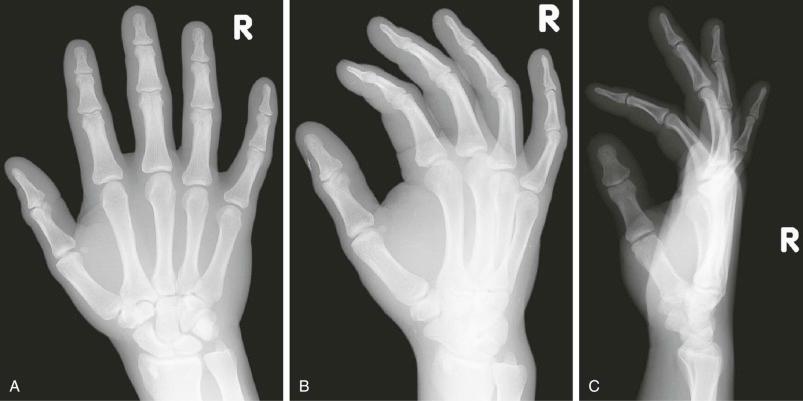
The posteroanterior view is taken with the palm down and the beam centered over the third metacarpal. This view is particularly helpful in the evaluation of the bases of the metacarpals and bases of the proximal phalanges. The posteroanterior view of the metacarpophalangeal joints of the second through fifth digits should form an M configuration, with loss of this configuration implying dislocations of these joints.
The lateral view is obtained with the ulnar side of the hand adjacent to the cassette. Superimposition of the metacarpals and phalanges may be overcome by partially fanning the fingers. The lateral view is important in evaluating rotation and angulation of fractures, as well as dislocations.
The oblique view is taken with the hand rotated approximately 45 degrees with the thumb up. This view more clearly evaluates the metacarpal heads and first and second carpometacarpal joints.
Fractures of the thumb require a dedicated two-view radiographic examination of the thumb, although an oblique view can be obtained with a posteroanterior examination of the whole hand. A true anteroposterior view of the thumb, called a Roberts view, is preferable ( eFig. 16-2 ); the posteroanterior view of the thumb is obtained more easily but has some ulnar-sided magnification compared with the anteroposterior view.
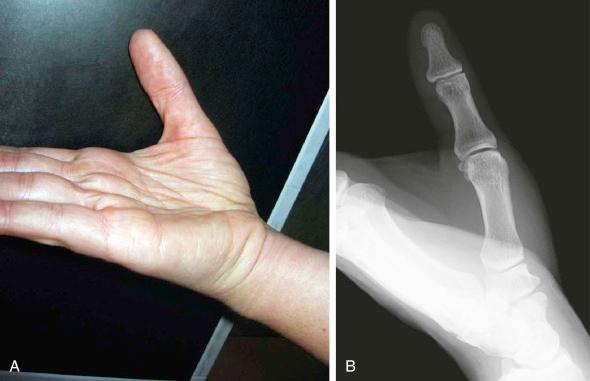
Soft tissue swelling about the joint is easily detected radiographically. When it is identified, the underlying joint should be examined carefully. Cortical avulsions usually occur at the margins of the joint at the base of the phalanges. These may be nondisplaced and seen on only one projection.
The Brewerton view can be used to evaluate abnormalities or fractures of the metacarpal heads, hook of the hamate, and the fourth and fifth carpometacarpal joints. This view is obtained by placing the palm up and the fingers flexed by about 65 degrees with the tube angled 15 degrees to the ulnar side of the wrist ( eFig. 16-3 ).
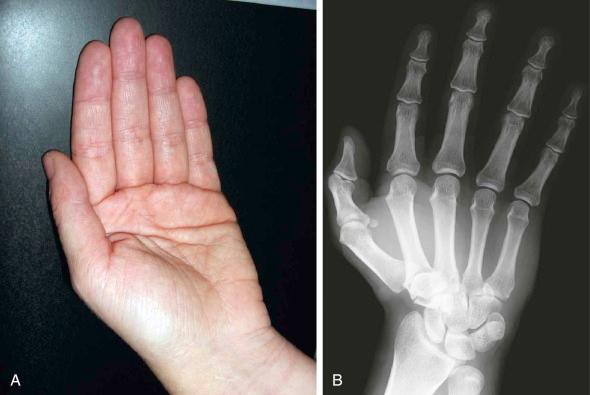
The Burman view provides improved visualization of the first carpometacarpal joint. To obtain this view, the hand is hyperextended and rotated radially so that the thumb is laid against the cassette and the beam is angled 45 degrees cephalad ( eFig. 16-4 ).

Tears of the ulnar collateral ligament of the thumb metacarpophalangeal joint (i.e., skier's thumb) present a special problem. In the absence of an associated bony avulsion of the distal metacarpal or proximal phalangeal base, the injury may be radiographically occult. In these cases, a stress examination of the joint with manually applied abduction stress (which can be gently applied by the patient or the examiner) may show subluxation compared with the contralateral, uninjured side. Although there is a theoretical risk of converting a nondisplaced ulnar collateral ligament tear into a displaced one by a stress examination, this is a rare occurrence.
Rarely is another modality required in evaluating fractures and dislocations. CT may be helpful in providing better operative planning in comminuted articular fractures, as seen in complete articular fractures at the base of the middle phalanx. CT can also help in the evaluation of occult fractures.
MRI can be used for detection of occult fractures or for the evaluation of infected joints. More frequently, MRI is used for its superior soft tissue contrast and is the study of choice for evaluation of tendon, ligamentous, and articular abnormalities.
Nuclear medicine is occasionally used. The most common indications for a three-phase bone scintiscan include evaluation of reflex sympathetic dystrophy, bone ischemia, occult osseous injury, and early infection/inflammation.
Ultrasonography has been reported to be used in the evaluation of osseous fractures but is more commonly performed in the evaluation of soft tissue structures, including tendon pathology and synovial disorders. However, high false-negative rates have been reported in children.
The thumb is unique compared with the rest of the phalanges in terms of both anatomic and functional characteristics, requiring special views for radiographic evaluation. There is considerable mobility at the normal first carpometacarpal joint that should not be mistaken for subluxation on various projections. The thumb also has unique patterns of injury in the setting of trauma.
An important distinction to recognize is whether the fracture is intraarticular or extraarticular. Intraarticular basilar fractures are more common than extraarticular fracture and are also considerably more demanding in terms of treatment.
This intraarticular fracture-dislocation of the first carpometacarpal joint was originally described by the Irish surgeon Edward Bennett in 1881. In one series, these fracture-dislocations made up approximately 34% of all fractures involving the thumb. There is characteristically an oblique fracture line at the base that separates the distal larger metacarpal fragment from the smaller avulsion fragment ( Fig. 16-1 ). Whereas the proximal avulsion fragment is often stable in position in relation to the trapezium, the larger distal fragment is unstable because of the pull of the abductor pollicis longus and flexor pollicis longus tendons and aided by the adductor pollicis muscles.
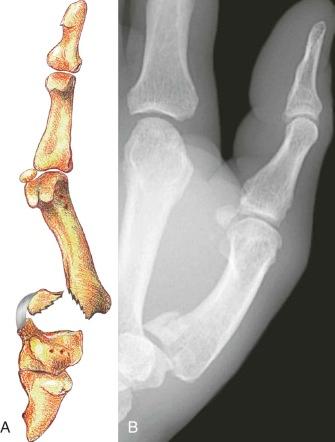
In rare cases, fracture may occur without subluxation or dislocation. Anatomic reduction can be accomplished by either open or closed means, but some type of operative fixation is usually recommended because cast immobilization alone is frequently unstable.
The second type of intraarticular fracture-dislocation of the first carpometacarpal joint was described by the Italian surgeon Silvio Rolando in 1910. Less common than Bennett's fracture, Rolando's fracture is seen in approximately 10% of all fractures of the first metacarpal. This is a comminuted Y- or T-shaped fracture-dislocation at the base of the thumb metacarpal ( Fig. 16-2 ). Dorsal dislocation of the distal metacarpal fragment also accompanies the disruption of the articular surface of the proximal thumb metacarpal.
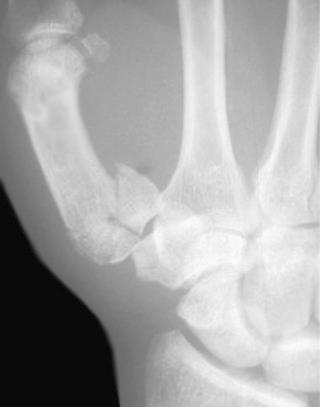
Management of Rolando's fracture is similar to that described for Bennett's fracture when only a few fragments are present. However, in cases of severe comminution or multiple fragments, successful pin fixation by either percutaneous or open means may be challenging for the surgeon, requiring additional methods. Therefore, it is important to describe the degree of comminution in these cases.
The ulnar collateral ligament is a ligamentous band that originates from the metacarpal head and inserts onto the medial aspect and base of the proximal phalanx of the thumb. Occasionally, acute rupture of the ulnar collateral ligament avulses a small portion of the proximal phalanx at its insertion, leading to skier's thumb ( Fig. 16-3 ). This fracture may involve a substantial portion of the articular surface of the proximal phalanx. Gamekeeper's thumb is chronic clinical instability of the first metacarpophalangeal joint caused by insufficiency/tearing of the ulnar collateral ligament of the thumb. If the bony avulsion is displaced significantly, operative treatment may be required.
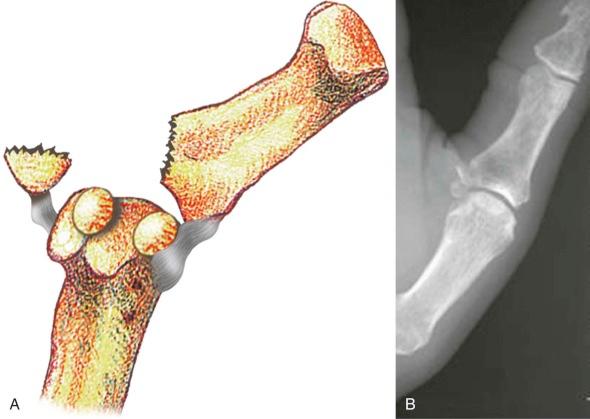
Significant initial subluxation of the joint may result in the Stener lesion. This occurs when the ruptured ulnar collateral ligament displaces superficial to the adductor aponeurosis and away from its site of insertion at the base of the proximal phalanx. This lesion is radiographically occult and may require MRI or ultrasonography for diagnosis. Stener lesions require open surgical intervention to reunite the torn ligament from its attachment.
Extra-articular fractures account for the remaining fractures of the proximal thumb, which comprise approximately 35% of all first metacarpal bone fractures. The majority of these fractures are transverse neck fractures with associated dorsal angulation and/or displacement of the distal fragment. A small number of extra-articular basilar fractures are of the oblique variety, which are more unstable and challenging both diagnostically and therapeutically. It is important to recognize these oblique extra-articular fractures as being separate from intraarticular fractures, specifically Bennett's fracture. The oblique extra-articular fractures can usually be treated by closed means alone, whereas the intraarticular fractures usually necessitate operative treatment.
Become a Clinical Tree membership for Full access and enjoy Unlimited articles
If you are a member. Log in here